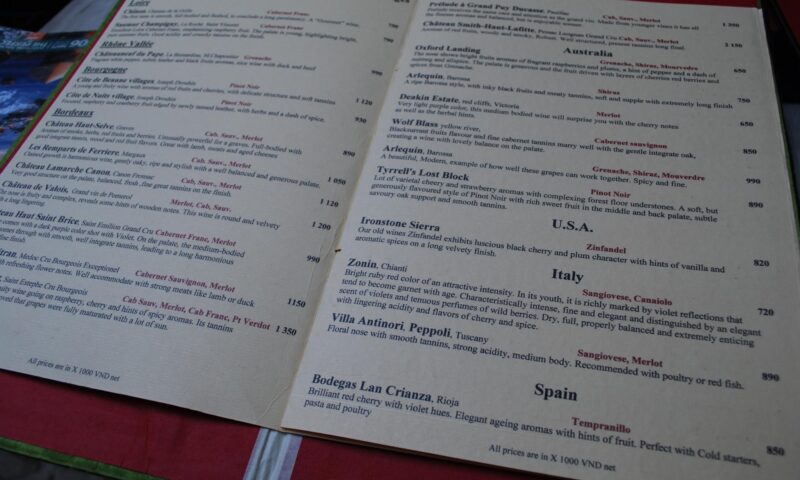
Are you a restaurateur looking to create or update your wine list? Or do you simply want to know how to build a wine list? We'll give you all the tips and tricks you need to create a well-balanced, readable wine list.
To comply with the law, your wine list must include: prices, trade names of wines and quantities served.
By law, you must indicate :
These are the 3 points you'll need to keep in mind when you start creating your wine list. When you create your wine list with Winevizer, this information is mandatory.
Ideally, the vintage should be displayed on the wine list to inform the customer of the vintage tasted, and this should correspond to the bottle presented.
Labels such as Bio, Demeter or Vegan can also be displayed on the wine list to satisfy certain customers who pay attention to them.
As your cuisine evolves with the seasons, adapt your wines according to the menus offered in your restaurant and the season. Certain types of wine go better with certain dishes. For example, offer fresher, lighter wines with cold dishes in spring and summer, or stronger, more tannic wines with stewed dishes in winter.
You can use Winevizer's "coup de coeur" or "featured wine" function to highlight a wine that works perfectly with the day's weather or current wine trends.
Many customers are keen to taste local wines in restaurants, especially in tourist areas. Try, if possible, to always offer local wines or wines produced in nearby wine-growing regions.
Look for suppliers such as wineries or cooperatives that can offer you local wines and products. Wine merchants are also great allies in your search for local wines.
If your cuisine is typical of a particular country, like an Italian or Spanish restaurant, look for wines from those countries.
If you want to keep a traditional paper wine list (rather than create a digital one), try to respect a few rules:
Whatever the size of your wine list, the most important thing is to keep it balanced and consistent. Customers need to be able to easily find what they're looking for and match it to their menu.
The list should offer a good overview of the different regions, with well-known appellations as well as more confidential or local ones. A diversified menu will suit both the most classic and the most curious customers.
Grape varieties are also important, and should be varied in the wines offered. This will simplify food and wine pairings.
Wine styles must also be taken into account for each color of wine. It will be interesting to offer light, fruity wines as well as powerful, tannic wines, or even balanced, complex wines.
Last but not least, wine prices should be in harmony with your menus. If you're offering low-price menus such as lunches, low-price wines should be able to accompany the meal, just as if you're offering a more upscale menu, fine, more expensive vintages should be available. Wine selections can also be a great way to showcase your wines.
You'd think that a wine list with lots of references would please everyone, but it actually tends to complicate the customer's task, as well as that of the restaurateur when it comes to stock and cellar management.
It's often the case that on a busy wine list, it's the price that will influence the customer, whereas a smaller list will allow the customer to be more curious about his or her choice. Faced with too wide a choice, the customer could end up frustrated or lost and end up not taking any wine at all. Find out how to choose the right wine for your restaurant.
Some customers may decide not to order a whole bottle of wine, for various reasons: drinking wine alone, the price, not wanting to spend the whole meal with the same wine. Wines by the glass are therefore a good way to sell wine. However, be careful not to offer too many wines by the glass if you don't have a system for storing the bottle for several days without altering the wine.
Selling wine by the glass also allows you to try out new wines, or to introduce more confidential wines that customers wouldn't buy without knowing about them.
Rather than simply displaying the name of the wine, its domain and appellation, why not leave a small tasting commentary that will help the customer get an idea of the wine's profile?
Leaving a tasting note that covers in a few words the visuals, aromas, flavors and pairings for each wine is a great way to show your customers that you've mastered your wine list.
The classification of wines on the menu must also be carefully thought out. There are two good ways to classify wines.
Final sorting can then be done by price or alphabetically, but this should not be the main sorting factor.
A good wine list should be renewed and not remain static. Regular customers could get bored of the wine selection.
Let your menu evolve, for example, according to the seasons, but also according to changes in your menu. You can keep part of your wine list static and another part regularly changing, which will keep all your customers happy. Evolving your range of wines by the glass can also be an easier way to get your menu moving.
One doesn't necessarily exclude the other. A digital wine list is much more flexible, easier to update and more fun for your customers. However, for some customers, the paper wine list is still a must-have, and you certainly won't be able to do without it. Offering your digital wine list on tablets can be a good compromise.
Pendant 1 mois sans engagement